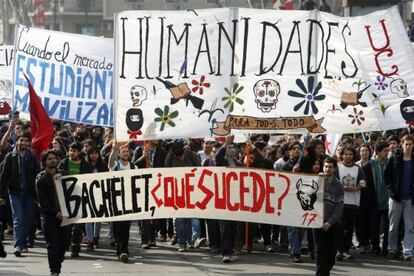The complicated journey of Bachelet’s flagship reforms
Chile’s administration will have to fight various sectors to build consensus around its plans


Thousands of students gathered on Thursday in Santiago de Chile to ask President Michelle Bachelet and parliament to listen to their ideas on educational reform, which has been the president’s flagship legislative project during her presidential campaign. The protests, though not as intense as the 2011 student demonstrations that shook up Sebastián Piñera’s government and the political class, were notable. Various groups have criticized the current administration for trying to please the students while it keeps protests under control. Chile’s youngsters, however, try to demonstrate their own power every time the administration – conscious of the complexities of the proposal – attempts to take a break and and clear up the confusion.
The educational reform package, which addresses the students’ main concerns, is ambitious in its reach and objectives. Juan Eduardo García-Huidobro, a scholar from Universidad Alberto Hurtado, says the measure “attempts to fight inequality in education, segregation and the current crisis in the public education system, and there is the great challenge of poor quality.” The objective is to destroy the model created in the 1980s, he said. “To move from an educational system ruled by commerce to one governed by the state, where education is considered a social right that must be made available to all regardless of social class, ethnicity, or region where the student lives.” What seems like a sensible goal carries political and technical complexities that are difficult to manage.
The government began without any clarity about the content of the educational reform, its timetable, and even less clarity about its priorities"
Jorge Navarrete, political analyst
On Tuesday, August 5, President Bachelet and high-ranking officials met in Palacio de Cerro Castillo in Viña del Mar, about 120 kilometers from Santiago. The goal of this special meeting was to call for unity among ministers and lawmakers and for support for the proposal, thus putting an end to the criticism coming from the president’s own New Majority coalition, an alliance that runs the political gamut from Christian Democrats to Communists. The purpose of the gathering was clear: Bachelet led the discussion and put her own political capital at risk to push for the measure. The turning point was when the Socialist leader decided to step to the front line, saying that an attack on this proposal was also a personal attack against her. This is saying a lot given that she was elected with 62 percent of the vote and, according to the Center of Public Studies (CEP), 50 percent of the population currently approves of her performance.
“It’s clear that this administration began without clarity about the content of the educational reform package, about its timetable and with even less clarity about its priorities,” Jorge Navarrete, a political analyst, says. According to the newspaper La Tercera, one factor played against the government. “The unnecessary pressure to make a concrete proposal before the first 100 days.”
Then, in May, Education Minister Nicolás Eyzaguirre decided to begin discussions with one of the nearly 10 legislative proposals in the reform package: the law that would prevent individuals from earning profits on public resources. The measure, which would affect 1.9 million students, would put an end to selective enrollment in subsidized private schools and abolish co-payment – the monthly fee parents pay for each child.
The government recognizes that beginning with this particular proposal was a risky strategy. Although it is the centerpiece of the reform package and one of the main concerns of the student movement, the administration did not take into account the potential pushback it might inspire in various sectors. Critics include opposition leaders, certain lawmakers from the president’s New Majority coalition, the Catholic Church and some middle-lower class voters. In the last few months, parents and managers of subsidized private schools – where most Chileans study – have criticized the measure publicly. Some have held demonstrations.
At its root, Bachelet’s proposal is contradictory, immature and lacks intellectual and technical ingenuity" José Joaquín Brunner, scholar
According to the CEP, 52 percent of parents are willing to pay for part of their children’s education if quality improves, a point critics have emphasized. The root of the problem is that Chileans do not trust the public educational system. Over the last decade, enrollment has fallen by 30 percent. The general opinion is that the reforms should have started with projects aimed at improving public establishments.
Minister Nicolás Eyzaguirre got in trouble and rumor had it that he might leave the administration just a few months after taking office. In fact, the Chilean Students Confederation (Confech) was unsure whether to participate in the meetings he held. But, the former director of the Western Hemisphere Department of the International Monetary Fund (IMF) has the backing of the president. Since the meeting at Cerro Castillo, she has become Eyzaguirre’s shield. Nothing, not even the minister’s own gaffes, have thrown him off. Or the polls, despite the fact that his popularity has fallen by 20 percent since Bachelet took office in March. According to Adimark, Eyzaguirre has a 44 percent approval rating and 50 percent say they are dissatisfied with his performance.
Will the president get the bill passed before the end of her term in March 2018? José Joaquín Brunner, a scholar and former Eduardo Frei Ruiz-Tagle minister has doubts. “To think that we will be able to move forward on all those fronts in just four years is completely ridiculous.” The researcher said the reform package requires big changes including Bachelet’s promise to make higher education free for all within six years. It is “contradictory, immature and lacks intellectual and technical ingenuity.” For one, he said, 10 percent of the richest students will receive 24 percent of public funding. In his last column published in El Mercurio, Brunner asked: “Is free universal higher education a possible and fair option before receiving quality education at the primary and secondary levels?”
Parliament will discuss the measure next semester.
In the meantime, the reform’s central proposal, which would eliminate profits, selective enrollment, and co-payment, began to move forward in the Chamber of Deputies, where Bachelet’s coalition holds a majority vote. Lawmakers took up the measure on Tuesday and they will have until September 9 to debate. Discussions are promising to be complicated, even within New Majority.
Yet, despite this apparent first victory, the Coordinating Assembly of Secondary School Students (ACES) took over the Ministry of Education building the next day. The police had to remove the protestors. The demonstration was a preview of the battles the administration will have to fight with various sectors in order to build consensus around these complex reforms – a task that will test the government’s political agility.
Meanwhile, La Moneda is trying to manage the discussion to buy time.
Translation: Dyane Jean François
Tu suscripción se está usando en otro dispositivo
¿Quieres añadir otro usuario a tu suscripción?
Si continúas leyendo en este dispositivo, no se podrá leer en el otro.
FlechaTu suscripción se está usando en otro dispositivo y solo puedes acceder a EL PAÍS desde un dispositivo a la vez.
Si quieres compartir tu cuenta, cambia tu suscripción a la modalidad Premium, así podrás añadir otro usuario. Cada uno accederá con su propia cuenta de email, lo que os permitirá personalizar vuestra experiencia en EL PAÍS.
¿Tienes una suscripción de empresa? Accede aquí para contratar más cuentas.
En el caso de no saber quién está usando tu cuenta, te recomendamos cambiar tu contraseña aquí.
Si decides continuar compartiendo tu cuenta, este mensaje se mostrará en tu dispositivo y en el de la otra persona que está usando tu cuenta de forma indefinida, afectando a tu experiencia de lectura. Puedes consultar aquí los términos y condiciones de la suscripción digital.
Últimas noticias
How Japan is trying to avert ‘digital defeat’
From digital curfews to blocking apps: How technology experts protect their children online
Why the price of coffee has skyrocketed: from Brazilian plantations to specialty coffee houses
Confined to a Cuban hospital: When electricity is a matter of life or death
Most viewed
- Pablo Escobar’s hippos: A serious environmental problem, 40 years on
- Reinhard Genzel, Nobel laureate in physics: ‘One-minute videos will never give you the truth’
- Why we lost the habit of sleeping in two segments and how that changed our sense of time
- Charles Dubouloz, mountaineering star, retires at 36 with a farewell tour inspired by Walter Bonatti
- The Florida Keys tourist paradise is besieged by immigration agents: ‘We’ve never seen anything like this’








































